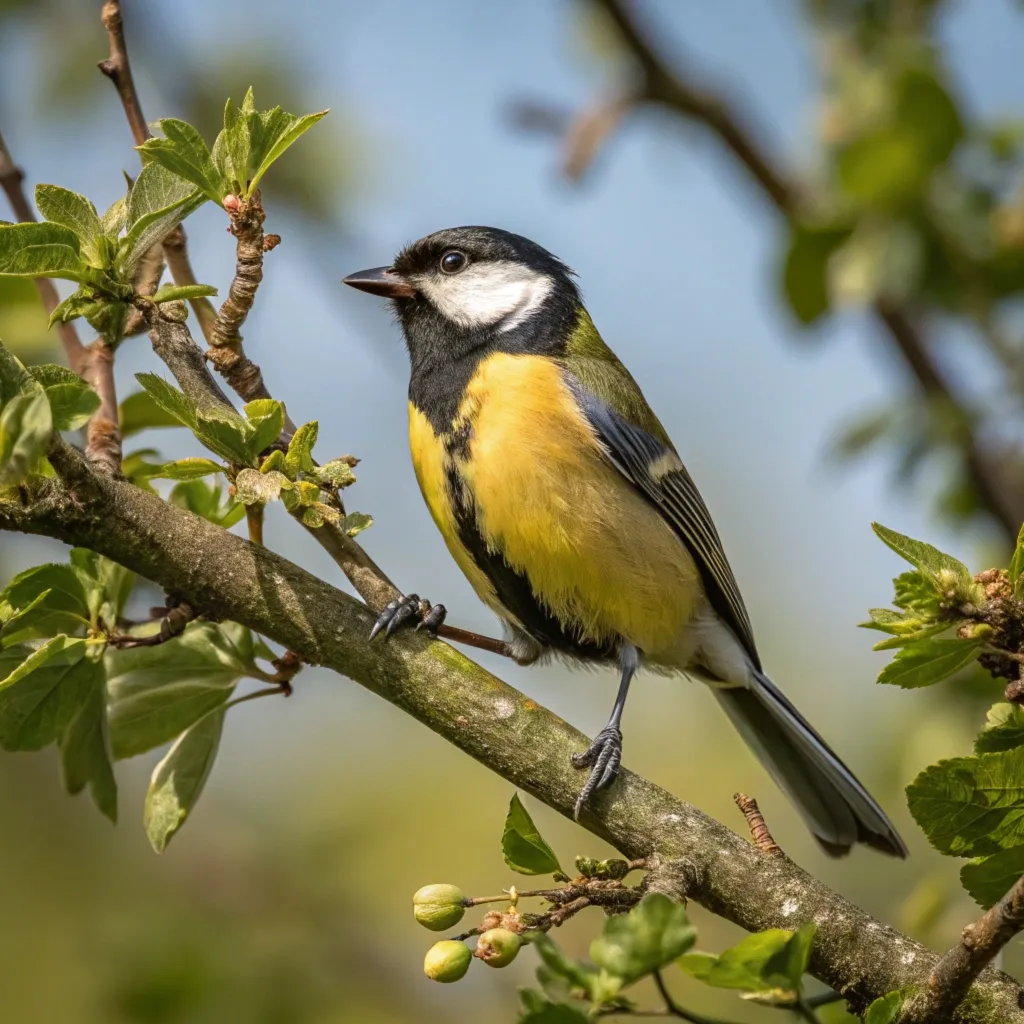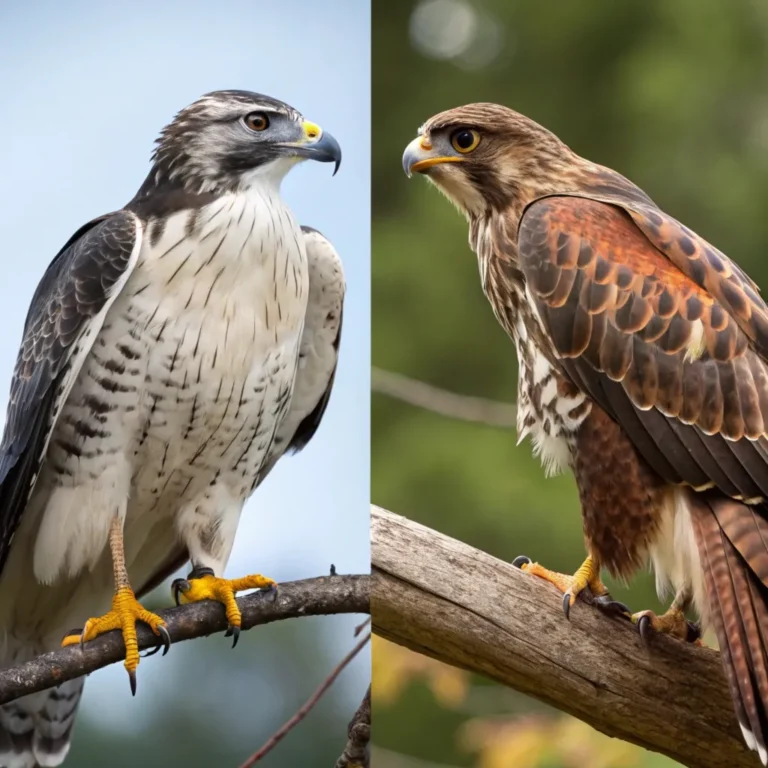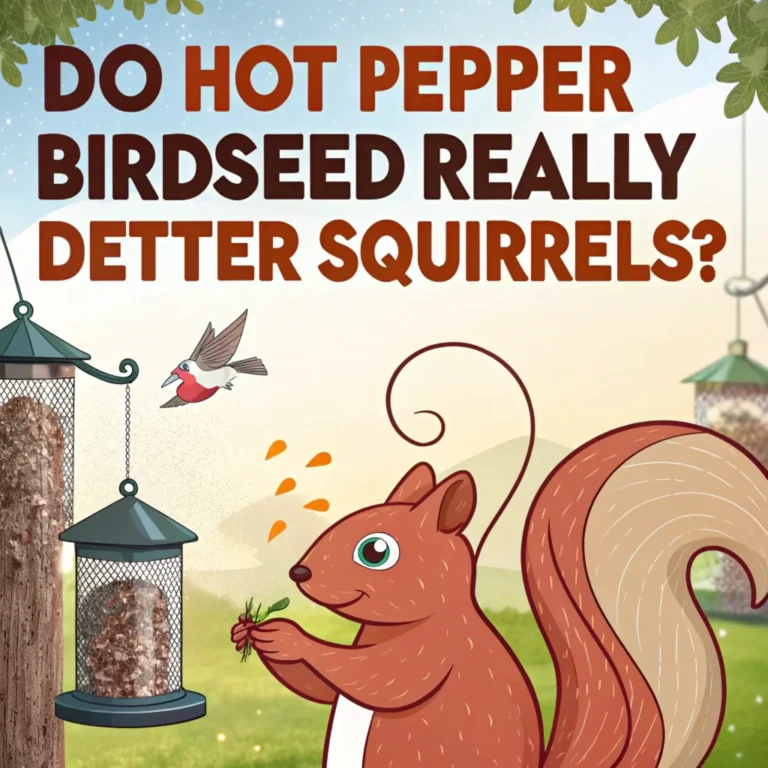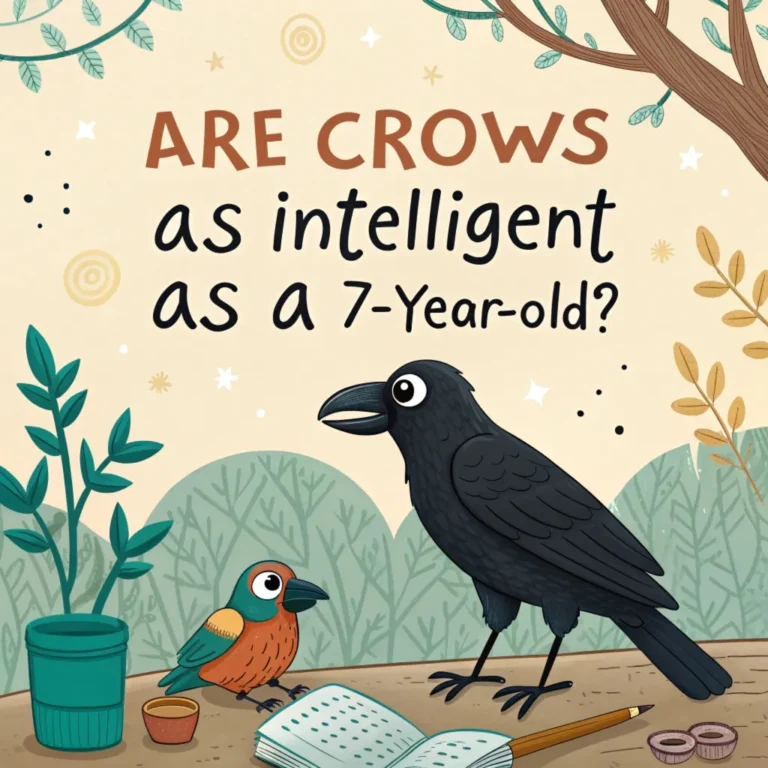The Great Tit: A Comprehensive Guide to Europe’s Charismatic Songbird
The great tit, a small but striking bird, captures attention with its bold colors and lively behavior.
This guide explores the world of the great tit, covering its appearance, habits, and role in nature. We will look at how this bird lives, what it eats, and why it matters to our ecosystems.
Learn about the great tit’s unique features, its adaptability to different environments, and the challenges it faces in today’s changing world.

Key Takeaways: Essential Facts About the Great Tit
- Appearance: The great tit features a black head, white cheeks, yellow underparts, and a distinctive black stripe down its chest.
- Size: Measuring 12.5-14.0 cm in length and weighing 16-21 grams, it is larger than most other tit species.
- Habitat: Great tits thrive in various environments, including deciduous woodlands, gardens, and urban parks.
- Diet: These birds are primarily insectivorous but also consume seeds and berries.
- Vocalization: Great tits possess a diverse repertoire of up to 40 different songs and calls.
- Nesting: They are cavity nesters, often utilizing tree holes or artificial nest boxes.
- Adaptability: Great tits have successfully adapted to human-altered environments.
- Distribution: The species is found across Europe, the Middle East, Central and Northern Asia, and parts of North Africa.
- Lifespan: While the typical lifespan is three years, some individuals can live up to 10 years.
- Conservation: Great tits face challenges from habitat loss and climate change, but remain common in many areas.
The great tit’s adaptability has allowed it to thrive in diverse environments, from pristine forests to bustling urban centers. This remarkable ability to adjust to changing conditions has contributed to its widespread distribution and popularity among bird enthusiasts.
As a result, the great tit serves as an excellent indicator species for environmental health and biodiversity in various ecosystems.
Despite their resilience, great tits face ongoing challenges in a rapidly changing world. Conservation efforts and public awareness play crucial roles in ensuring the continued success of this beloved species.
Identifying the Great Tit: A Colorful Character
The great tit boasts a striking appearance that sets it apart from other bird species. Its black head and throat contrast sharply with its bright yellow underparts.
The bird’s back displays an olive-green hue, while its wings feature a white bar. A bold black stripe runs down the center of its yellow breast, creating a distinctive pattern.
Male and female great tits share similar plumage, making gender identification challenging for casual observers. However, males often exhibit a slightly wider black stripe on their breast and more vibrant overall coloration.
The great tit’s distinctive markings serve multiple purposes in its natural habitat. The bold contrast between its black head and white cheeks helps with species recognition, facilitating social interactions and territorial displays.
Additionally, the bright yellow underparts may play a role in mate attraction, with more vibrant individuals potentially signaling better health and genetic fitness to potential partners.
While the great tit’s appearance remains relatively consistent across its range, subtle variations in plumage coloration and pattern intensity can be observed in different populations, reflecting adaptations to local environments.
Habitat and Distribution: Adaptable Residents

Great tits demonstrate remarkable adaptability, thriving in a variety of habitats. These birds inhabit:
- Deciduous and mixed forests
- Forest edges
- Urban parks and gardens
- Orchards
- Hedgerows
Their distribution spans a vast area, including:
- Europe
- Middle East
- Central and Northern Asia
- Parts of North Africa
Great tits have successfully adapted to human-altered environments, becoming familiar visitors to urban and suburban areas.
The great tit’s ability to thrive in diverse habitats is a testament to its ecological flexibility. This adaptability has allowed the species to colonize new areas and maintain stable populations even as landscapes change.
In urban environments, great tits have demonstrated remarkable behavioral plasticity, adjusting their foraging and nesting habits to take advantage of human-provided resources such as bird feeders and nest boxes.
Research has shown that urban great tits may differ from their forest-dwelling counterparts in various aspects, including song characteristics, stress responses, and breeding timing.
Feeding Habits: Versatile Foragers
Great tits exhibit diverse feeding behaviors, adapting their diet to seasonal availability. Their diet includes:
- Insects and spiders (primary food source during breeding season)
- Seeds (especially in winter)
- Berries and fruits
- Nectar (occasionally)
These birds forage actively, using their strong beaks to probe bark crevices and leaves for hidden prey. Their acrobatic abilities allow them to hang upside down from branches, accessing food sources that other birds might miss.
The great tit’s feeding habits showcase its remarkable adaptability and problem-solving skills. These birds have been observed using innovative techniques to access food, such as learning to pierce milk bottle caps to drink cream in some areas.
This behavior demonstrates their cognitive flexibility and ability to exploit new food sources, contributing to their success in diverse environments.
Great tits also play a crucial role in natural pest control, consuming large quantities of insects that may be harmful to plants and crops.
Nesting and Breeding: Cavity Dwellers

Great tits are cavity nesters, preferring to build their nests in:
- Natural tree hollows
- Artificial nest boxes
- Crevices in buildings
The female constructs the nest using:
- Moss
- Grass
- Feathers
- Animal hair
A typical clutch consists of 6-12 eggs, which the female incubates for approximately two weeks. Both parents participate in feeding the chicks, which fledge after about three weeks.
The nesting behavior of great tits highlights their adaptability and close association with human-altered landscapes.
In areas where natural cavities are scarce, these birds readily accept artificial nest boxes, making them popular subjects for citizen science projects and backyard conservation efforts.
This adaptability has allowed great tit populations to thrive even in highly urbanized environments.
Great tits exhibit remarkable parental care, with both parents investing significant energy in raising their young. This cooperative breeding strategy contributes to the species’ success.
Vocalizations: A Diverse Repertoire
Great tits are known for their varied and complex vocalizations. Their repertoire includes:
- Territorial songs
- Alarm calls
- Contact calls
The most recognizable call is often described as a clear, two-note “teacher-teacher” sound. However, great tits can produce up to 40 different vocalizations, showcasing their impressive vocal abilities.
The vocal complexity of great tits has made them valuable subjects for research in avian communication and cognition.
Studies have revealed that great tits can learn and mimic the alarm calls of other bird species, demonstrating a sophisticated level of vocal learning and inter-species communication. This ability likely enhances their survival in mixed-species flocks and diverse habitats.
Recent research has also explored how urban noise affects great tit vocalizations, with some populations adapting their songs to be heard above city sounds.
Social Behavior: Intelligent and Adaptable

Great tits display remarkable intelligence and social behavior. They exhibit:
- Tool use (observed using pine needles to extract larvae from bark)
- Social learning (acquiring new skills by observing others)
- Flock formation (especially in winter)
These birds often form mixed-species flocks with other tit species, benefiting from increased foraging efficiency and predator detection.
The social intelligence of great tits extends beyond simple flock behavior. These birds have demonstrated the ability to learn from each other, rapidly spreading new behaviors through populations.
This capacity for social learning has been observed in various contexts, from novel foraging techniques to the use of human-provided resources. Such behavioral flexibility contributes to the species’ success in adapting to changing environments.
Great tits also exhibit complex social hierarchies within their flocks, with dominance relationships influencing access to food and mates.
Conservation Status: Challenges and Opportunities
While great tits remain common across much of their range, they face several conservation challenges:
- Habitat loss due to urbanization and agricultural intensification
- Climate change affecting breeding timing and food availability
- Competition for nesting sites with other cavity-nesting species
Conservation efforts focus on:
- Preserving and creating suitable habitats
- Providing artificial nest boxes
- Reducing pesticide use to maintain insect populations
The conservation status of great tits serves as a barometer for broader environmental health. While the species is not currently threatened, monitoring their populations provides valuable insights into the impacts of climate change and habitat alteration on woodland ecosystems.
Conservation initiatives often use great tits as flagship species to promote broader biodiversity protection measures.
Citizen science projects involving great tits have become increasingly popular, engaging the public in data collection and conservation awareness.
Great Tits in Human Culture: Backyard Favorites

Great tits have endeared themselves to humans, becoming popular backyard visitors. Their bold behavior and striking appearance make them favorites among birdwatchers and garden enthusiasts.
To attract great tits to your garden:
- Install nest boxes
- Provide suitable food (sunflower seeds, peanuts, suet)
- Maintain a water source for drinking and bathing
The cultural significance of great tits extends beyond their role as backyard visitors. These charismatic birds have inspired artists, writers, and naturalists for centuries, appearing in various forms of art and literature.
Their presence in urban and suburban environments has made them ambassadors for nature, helping to connect people with wildlife even in densely populated areas.
Great tits have also become popular subjects for wildlife photography, captivating audiences with their vibrant colors and expressive behaviors.
Research and Citizen Science: Contributing to Knowledge
Great tits serve as important subjects for scientific research, particularly in studies of:
- Climate change impacts on bird populations
- Animal behavior and cognition
- Urban ecology
Citizen science projects often involve monitoring great tit populations, allowing amateur naturalists to contribute valuable data to scientific research.
The extensive research conducted on great tits has significantly advanced our understanding of avian biology and ecology. Long-term studies of great tit populations have provided crucial insights into the effects of climate change on breeding patterns and food availability.
Additionally, research on great tit cognition has revealed surprising levels of problem-solving abilities and social learning, challenging previous assumptions about bird intelligence.
Citizen science initiatives focused on great tits have successfully engaged the public in scientific research, fostering a greater appreciation for biodiversity.
The Great Tit’s Role in Ecosystems: Natural Pest Control
Great tits play a crucial role in ecosystem balance by:
- Controlling insect populations
- Dispersing seeds
- Serving as prey for larger predators
Their insectivorous diet makes them valuable allies in natural pest control, particularly in agricultural and forest ecosystems.
The ecological importance of great tits extends beyond their role in pest control. As both predators and prey, they occupy a crucial position in food webs, influencing the population dynamics of various species.
Their foraging behavior can also impact plant communities through seed dispersal and pollination, albeit to a lesser extent than some other bird species.
Research has shown that the presence of great tits can have cascading effects on ecosystem health, highlighting their value in biodiversity conservation.
Adaptations for Survival: Built for Success
Great tits possess several adaptations that contribute to their success:
- Strong beaks for cracking seeds and probing bark
- Excellent color vision for locating food and detecting predators
- Ability to lower body temperature during cold nights to conserve energy
These adaptations allow great tits to thrive in diverse environments and weather conditions.
The physiological adaptations of great tits demonstrate the species’ remarkable evolutionary success.
Their ability to enter a state of controlled hypothermia, known as torpor, allows them to conserve energy during cold winter nights, significantly enhancing their survival rates in harsh conditions.
This adaptation, combined with their versatile diet and strong beaks, enables great tits to exploit a wide range of food sources throughout the year.
Recent studies have also revealed that great tits possess ultraviolet vision, enhancing their ability to detect ripe fruits and assess potential mates.
Threats and Predators: Navigating Dangers
Despite their adaptability, great tits face various threats:
- Predation by sparrowhawks, domestic cats, and other predators
- Nest parasitism by cuckoos
- Competition for nesting sites with other cavity-nesting species
Great tits have developed strategies to mitigate these threats, including vigilant behavior and mobbing of potential predators.
The diverse array of threats faced by great tits highlights the complex challenges of survival in both natural and human-altered environments.
While their adaptability has allowed them to cope with many of these pressures, some threats, such as increased predation by domestic cats in urban areas, pose significant challenges.
Great tits have evolved various anti-predator behaviors, including sophisticated alarm calls that communicate specific information about the type and location of threats.
Ongoing research focuses on understanding how great tits balance the trade-offs between predator avoidance and other essential activities like foraging and breeding.
Frequently Asked Questions About Great Tits
How long do great tits live?
Great tits typically live for about three years in the wild, although some individuals have been recorded living up to 10 years.
What do great tits eat?
Great tits primarily consume insects and spiders during the breeding season. In winter, they supplement their diet with seeds, berries, and nuts.
How can I attract great tits to my garden?
To attract great tits, provide suitable food such as sunflower seeds and peanuts, install nest boxes, and maintain a water source for drinking and bathing.
Are great tits migratory?
Most great tit populations are non-migratory, remaining in their territories year-round. However, some northern populations may move short distances in harsh winters.
How can I tell the difference between male and female great tits?
Male and female great tits look very similar. However, males often have a slightly wider black stripe on their breast and more vibrant overall coloration.
In conclusion, the great tit stands out as a remarkable and adaptable bird species, captivating both casual observers and seasoned ornithologists alike.
Its striking appearance, diverse vocalizations, and intelligent behavior make it a favorite among backyard birdwatchers and researchers.
As we continue to study and appreciate these charismatic birds, we gain valuable insights into avian ecology, behavior, and the impacts of environmental change on our feathered neighbors.
The great tit’s success story serves as a testament to the resilience of nature and the importance of adaptability in a changing world.
By understanding and protecting these charismatic birds, we not only ensure their continued presence in our ecosystems but also gain valuable insights into the broader challenges facing wildlife in the 21st century.
As we move forward, the great tit will undoubtedly continue to play a crucial role in both scientific research and public engagement with nature conservation.

Joyce is the passionate founder of Chirping Hearts, a website dedicated to sharing her love for birds and providing valuable information about avian life. With a background in ornithology and years of experience in birdwatching, Joyce aims to inspire others to appreciate the beauty and diversity of birds. Through her engaging articles and guides, she hopes to foster a community of bird enthusiasts who share her enthusiasm for these incredible creatures. When she’s not writing, Joyce enjoys exploring nature trails and observing birds in their natural habitats.







